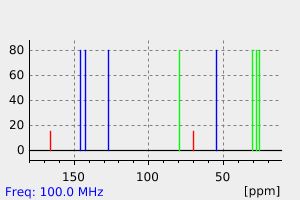1,2-trimethylenenorborna-2,5-diene | 74829-76-8
中文名称
——
中文别名
——
英文名称
1,2-trimethylenenorborna-2,5-diene
英文别名
Jtujpuphygguqz-uhfffaoysa-;tricyclo[5.2.1.01,5]deca-5,8-diene
CAS
74829-76-8
化学式
C10H12
mdl
——
分子量
132.205
InChiKey
JTUJPUPHYGGUQZ-UHFFFAOYSA-N
BEILSTEIN
——
EINECS
——
-
物化性质
-
计算性质
-
ADMET
-
安全信息
-
SDS
-
制备方法与用途
-
上下游信息
-
文献信息
-
表征谱图
-
同类化合物
-
相关功能分类
-
相关结构分类
物化性质
-
沸点:215.9±15.0 °C(Predicted)
-
密度:1.05±0.1 g/cm3(Predicted)
计算性质
-
辛醇/水分配系数(LogP):2.7
-
重原子数:10
-
可旋转键数:0
-
环数:3.0
-
sp3杂化的碳原子比例:0.6
-
拓扑面积:0
-
氢给体数:0
-
氢受体数:0
上下游信息
反应信息
-
作为反应物:描述:1,2-trimethylenenorborna-2,5-diene 在 三乙基硅烷 、 氢氧化钾 、 三氟化硼 、 potassium tert-butylate 、 三氟乙酸 、 4-2-吡啶偶氮-N,N-二甲氧基苯胺 作用下, 以 甲醇 、 二氯甲烷 、 溶剂黄146 、 叔丁醇 为溶剂, 反应 4.08h, 生成 2-endo,6-endo-trimethylene-8,9,10-trinorbornane参考文献:名称:1,2-三亚甲基降冰片烷的金刚烷重排。第五部分。C(2)和C(6)处碳正离子中心区域选择性形成引发的1,2-三亚甲基降冰片烷重排†摘要:为了研究1,2的金刚烷重排中简并重排E⇄M的发生或不存在,研究了1,2-三亚甲基降冰片烷在C(2)和C(6)上的区域选择性生成碳正离子中心的行为。-内-(1)和1,2-外-三亚甲基降冰片烷(2)至2-内,6-内-三亚甲基降冰片烷(3)。不可避免地涉及简并重排E⇄M,因为不仅由反应物4(C(2),C(3)-烯烃)的转化表明直接形成1,2-三亚甲基降冰片-2-基阳离子E和6(C(2),C(3')-烯烃),但如果要电离的C(6)上的离去基团占据内位(6-内醇8),也可以间接地(通过FE)。没有简并重排的E⇄M是从直接导致2,6-三亚甲基降冰片-2-基阳离子G的反应物开始的;在具有立体电子偏爱构型的同时具有离开的OH-基团的6- exo-酒精10进行电离时,会同时经历C(1),C(2)-键迁移(G)和质子化的情况烯烃13的后续反应是相同的。DOI:10.1002/hlca.19850680323
-
作为产物:描述:参考文献:名称:1,2-内切-Trimethylenenorbornane。金刚烷的新型异构体摘要:描述了一种新的金刚烷异构体1,2内-三亚甲基降冰片烷(2)的简便方法。从五-4-炔基环戊二烯3的混合物开始,通过分子内环加成(4)和随后的C(5),C(6)双键区域选择性还原来制备三环单饱和关键中间体5。通过二酰亚胺的立体选择性氢化从5获得标题烃2。此外,使用二氘二碘亚胺制备了2的氘代类似物。化合物2重排至2个内,6个内硫酸中的-三亚甲基降冰片烷(4-均丁烯,10),以及二硫化碳中的溴化铝。DOI:10.1002/hlca.19800630414
文献信息
-
KLESTER, A. M.;GANTER, C., HELV. CHIM. ACTA, 1985, 68, N 3, 734-744作者:KLESTER, A. M.、GANTER, C.DOI:——日期:——
表征谱图
-
氢谱1HNMR
-
质谱MS
-
碳谱13CNMR
-
红外IR
-
拉曼Raman
-
峰位数据
-
峰位匹配
-
表征信息
同类化合物
降冰片烯
金刚烷-D16
金刚烷
螺戊烷
螺二環己烷
螺[5.6]十二烷
螺[5.5]十一碳-4-烯
螺[5.2]辛-2-烯
螺[4.5]癸烷
螺[4.4]壬-8-烯
螺[3.4]辛烷
螺[3.4]辛-7-烯
螺[3.3]庚-2,5-二烯
螺[2.5]辛烷
螺[2.5]辛-7-烯
螺[2.5]辛-5,7-二烯
螺[2.4]庚-4,6-二烯
螺[2.4]庚-1-烯
螺[2.3]己-1-烯
螺[2.2]戊-1-烯
螺<二环<2.2.2>辛-5-烯-2,1'-环丙烷>
螺<4.4>壬-1,3,7-三烯
螺<4.4>壬-1,3,6,8-四烯
螺(4.4)壬烷
螺(4.4)壬-1,3-二烯
螺(3.4)辛-5,7-二烯
trans-perhydroazulene
萘烷
萘,1,2,3,4,4a,8a-六氢-,顺-
美罗培南中间体F9
篮烷
立方烷
氨基甲硫酸,二甲基-,O,O-(3,3-二甲基1,1-联苯基-2,2-二基)酯
棱晶烷
杜瓦苯
新戊基-1金刚烷
抗氧化剂TH-CPL
庚搭烯
四螺[2.0.2:0.2:0.2:0]十二烷
四螺[2.0.0.0.2.1.1.1]十一烷,顺-
四环己基铅
四环[5.3.0.0<2,6>.0<3,10>]癸-4,8-二烯
四环[5.3.0.0(2,6).0(3,10)]癸烷
四环[4.4.0.02,10.03,7]癸-4,8-二烯
四环[4.2.2.26,5.01,6]十二烷
四环[4.2.0.02,5.03,8]辛烷
四环[3.3.0.02,4.03,6]辛-7-烯
四环<5.3.1.02,6.04,9>十一烷
四环(8.2.2.22,5.26,9)十八碳-1,5,9-三烯
四环(4.1.0.0(2,4).0(3,5))庚烷







